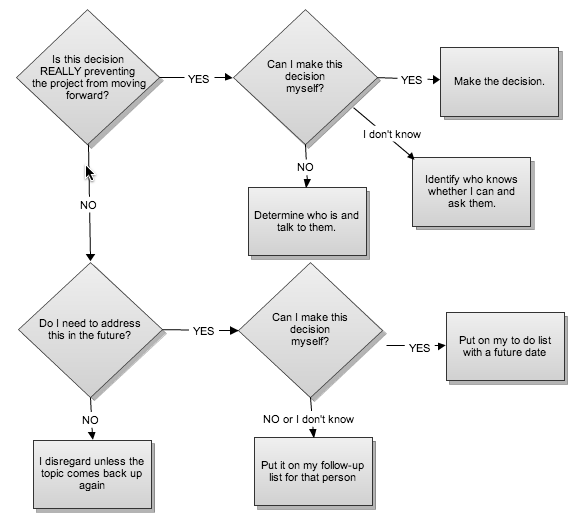In project management decision-making is inevitable. In fact, I have come to think that project management is primarily about making sure the necessary decisions get made at the right point in time.
Recent my co-worker Nathan R Elson, wrote a blog about the decision parallax. (I’ll be the first to admit I had to look up the word parallax!) I really dig the practical aspect of understanding how to make a decision that helps short circuits procrastination and allows forward movement.
Question 1: Ask will the project be derailed if I don’t have an answer to this right now? This determines priority and urgency. Failure to answer this question correctly can mean that you’ll either get stuck because there are too many decisions to make OR that something on the project will be “blowing up” soon.
- If the answer is yes, the first decision has been made! You’ve decided to decide. Proceed to question 2.
- If the answer is no, the first decision has been made! You don’t need to decide right now. Because I use a modified version of GTD (Getting Things Done) I ask myself another question (question 1a): will I need to address this at some point? If not, I disregard it unless it comes up again. If yes, I proceed to question 2.
Question 2: Ask can/may I make this decision? This determine whether I am allowed to and whether I have the information necessary to make an effective decision.
If I previously answered question 1 with “yes, my project will be derailed if I don’t get an answer right now”, then the answer to question 2 prompts these actions:
- “Yes, I can make this decision” = make it and move forward without procrastinating.
- “I’m allowed to but I don’t have enough information” = seek out the input that is missing and then make the decision and move forward without procrastinating.
- “I don’t know if I’m allowed to make this decision” = ask someone who has the authority to decide whether I can make the decision or not. This is different from asking them to make the decision. Don’t procrastinate on asking them.
Some people I know rarely landing here because they prefer to “ask for forgiveness later”. I default to thinking I don’t have permission, so I include this option for “ask for permission first” people like me. - “No, I’m not allowed to make this decision” = ask the person who can make the decision to make a decision and follow-up until you get one.
If I previously answered question 1 with “no, my project won’t derail if I don’t get an answer now” and question 1a with “yes, I’ll need to address this at some point in the future”, then the answer to question 2 prompts these actions:
- “Yes, I can make this decision” = I put it on my to do list with a due date so I don’t have to think about it until my system reminds me.
- “I don’t know,” “I don’t have enough information” or “No, I can’t make this decision”: I add this to my list of follow-up items for an individual person.
To do lists
Yes, I have an epic list of future items that will need to be decided. I use Wunderlist to keep them organized.
Follow-up Items
There are decision makers that I always have a long list of items for. Over time I’ve worked out a system that works for me and for the individual decisions makers. For example:
- With my boss, every week we have an hour meeting. Beforehand I send him my complete list of open items (with high priority ones highlighted) along with my weekly update. This list is probably 2-4 pages long and we’ve worked out a system that allows us to get through most of them in 30-40 minutes.
- With directors and executives, I schedule 15 or 30 minute working meetings whenever items on their list get urgent enough to need their input. I rarely send them my entire list of open items.


